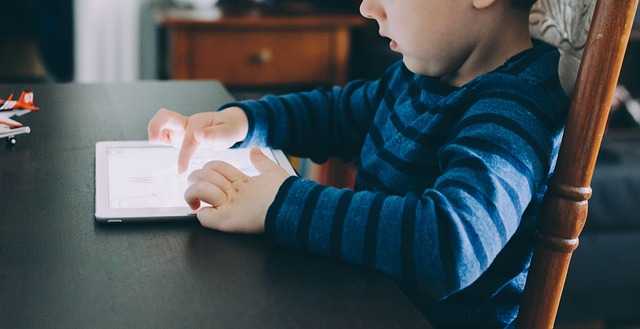Basking in Blue Light
This image is all too familiar, isn’t it? Children staring at electronic screens—playing games, reading, or doing homework.
What’s not shown is a parent sitting across the table doing the same thing—playing games, reading, or working.
Research is slowly revealing some of the dangers of electronic screens and I recently wrote an article on the effect screen time has on children.
The research showed a decrease in brain function in children who looked at an electronic screen for more than two hours (total time) per day. This was not good news. Nope, not even a little.
One of the unanswered questions from the research was the unknown effect of blue light on the developing brain of a child or on the already developed brain of an adult, for that matter.
Blue light wavelengths, common during daylight hours, are beneficial because they boost attention, reaction times, and mood. Blue wavelengths do not appear much during the nighttime hours–except via manmade lighting–especially electronic screens and those new, energy-efficient lights.
Is this exposure to blue light during the evening hours dangerous? Research is ongoing, but here’s what we already know from past research. Exposure to light at night (such as happens to those who work at night) decreases the body’s production of melatonin. Melatonin is a chemical in the body which promotes sleep. Blue light exposure at night interferes with melatonin production more than other wavelengths of light. We don’t know if it’s dangerous, yet. But we already know it isn’t healthy.
Back to our child basking in the glow from his iPad, we do not know the effect of that blue light on his eyes or his brain. We do know blue light impacts sleep and research is clear, children need more sleep than they are getting.
Am I going to tell you to throw out your electronic screens? No, I’m not. You wouldn’t toss them even if I did.
Face it, electronic screens are part of our lives. They’re not going anywhere anytime soon.
What’s a concerned parent to do?
Here are a few takeaway tips:
- Limit total screentime exposure to two hours (total). This adds up quickly.
- NO screentime (includes TV) two to three hours BEFORE bed. Not even educational stuff or Disney anything.
- Replace your screentime before bed with book reading and prayer time.
Now that you know more about blue light and how it may affect your children and you, let’s start a conversation on how we can minimize the dangers. Follow this blog ’cause I’ll be posting more next week.
Your homework is:
Get a good number on how many hours per day your children are on an electronic screen. Yes, there’s an app for that. Try Moment which allows you to track the usage for your family on all devices.
Or, find something you like better. But, this week let’s get a handle on how many hours (total time) per day each child is basking in the blue light.
Here’s a verse you can use when your children begin calling you a mean mom:
“I can do all things through Christ who strengthens me.”Philippians 4:13
If you have suggestions on apps or ways to track this time, I’d love for you to share…
Let’s bask more in the light of God and less time in the blue light of a machine.
Who’s with me?
(image from Pixabay)


The Conversation
I am! Thank you for this informative and helpful post. We all need to guard our minds, hearts and eyes.
Thank you. I’ll be posting more on this next week.
Thanks for reading, Melissa. I appreciate your support. Yes, we have to guard our eyes, minds, and heart and, in addition, those of our little ones.
[…] talked last week about the dangers blue light (commonly emanating from […]
[…] sure you saw the bluish light reflected on her face. More info on blue light is in a previous post. Click here. When she got the phone again, what did she do? It’s like a switch was flipped and she […]